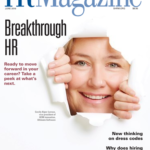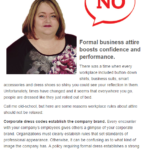Corporate dress codes have been around as long as facsimile machines and mod office furniture. I’m pretty sure that the fashion show at work was pretty interesting before HR policies came along to crack down on potentially offensive attire. (Like our mothers’ too short mini-skirts and our fathers’ polyester leisure suits) There’s a reason they call it ‘dress codes’ and back then it was to protect the reputation of young ladies.
Check out some of these dandies from days-gone-by:

Office workers, Detroit, 1968, by Enrico Natali
As an HR professional, I am continually reminded that not everyone has the same ideas concerning proper office attire. Even in our time, when casual dress codes rule the workplace, there are always employees who try to stretch the boundaries. When I first worked in the recruitment space, nearly every week someone would come in looking for a job, but looking less than prepared for the part. Ripped up jeans, flip flops, overly revealing tops, and tight clothing were the norm for some folks. Others came in adorned in their bedclothes or sporting over-the-top hair styles.
When this happened, I would gently take the person aside to explain that there were certain standards of decorum expected by employers and send them home to change into something a little more conservative. I became aware that sometimes people had never considered their attire as part of their image, nor did anyone ever give them guidance on what to wear to work. To me, that was kind of sad and I felt like a mother-hen explaining the rules of life to a baby chick.
Then there have been other situations, where I was the employee. I’ve held several jobs where I was required to wear black pants, white shirts, closed toe black shoes, and no jewelry. It was uncomfortable sometimes, and I didn’t care for it. But it did make things easy for me. I didn’t have to worry about going out to buy a bunch of clothes all the time to stay in fashion. I didn’t have to think much in the mornings about what I would wear, so I was never late to work. All of my peers and I were on even ground, and I felt a sense of belonging to something greater.
Dress codes, while arguably not the most popular of HR policies, have their place in work environments. They are especially important for team building and safety reasons.
This month, I finally got a chance to have my say concerning corporate dress code policies. You’ll see it in the June edition of HR Magazine where I have the pleasure of being an advocate for dress codes. I hope you will find the time to read it. Ponder your own workplace. Does it need a dress code? If so, why?
Should Companies Relax Dress Codes?



